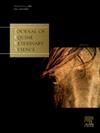Detection of fungal and bacterial organisms from clinical uterine samples of horses using next-generation sequencing in comparison with culture
IF 1.6
3区 农林科学
Q2 VETERINARY SCIENCES
引用次数: 0
Abstract
Fungal and bacterial culture is currently the primary method for pathogen detection and identification. Next-generation sequencing is a powerful method for detecting and identifying the presence of microbial DNA in samples. We evaluated the correlation between fungal and bacterial culture with next-generation sequencing in equine uterine samples. Fungal cultures (n=63) were evaluated based on their culture results. In culture positive (n=16) samples, next-generation sequencing identified the same organism in 10 samples (62.5%), 5 samples did not identify fungal agents, and 1 sample identified other species of fungal agents. In no growth samples (n=42), next-generation sequencing did not identify fungal agents in 37 samples (88.1%), 4 samples had a potential fungal pathogen identified, and one sample identified only non-pathogenic fungal organisms. Fungal culture and next-generation sequencing had an 80% agreement and moderate correlation by Kappa coefficient (0.508). Bacterial culture (n=57) was also evaluated based on bacterial culture results. In bacterial culture Positive samples (n=32), next-generation sequencing identified the same organism in 25 (78.1%) samples, and identified different organisms from the remaining 7 samples. In bacterial no growth samples (n=14), next-generation sequencing detected bacterial presence in 5 samples, and 9 samples had no bacterial DNA identified. The agreement between bacterial culture and next-generation sequencing was 74% with a moderate correlation by Kappa coefficient (0.46). In conclusion, culture and next-generation sequencing have moderate correlation, and next-generation sequencing has the potential as a diagnostic option for enhancing pathogen detection for equine endometritis.
使用下一代测序技术检测马匹临床子宫样本中的真菌和细菌,并与培养法进行比较。
目前,真菌和细菌培养是病原体检测和鉴定的主要方法。下一代测序是检测和鉴定样本中微生物 DNA 存在的一种有效方法。我们评估了马子宫样本中真菌和细菌培养与新一代测序之间的相关性。真菌培养(n=63)根据培养结果进行评估。在培养阳性样本(n=16)中,新一代测序在 10 个样本(62.5%)中鉴定出了相同的生物体,5 个样本未鉴定出真菌病原体,1 个样本鉴定出了其他种类的真菌病原体。在无生长样本(n=42)中,37 个样本(88.1%)的新一代测序未鉴定出真菌病原体,4 个样本鉴定出潜在的真菌病原体,1 个样本仅鉴定出非致病性真菌生物。根据卡帕系数(0.508),真菌培养和新一代测序的一致性为 80%,相关性为中等。细菌培养(n=57)也是根据细菌培养结果进行评估的。在细菌培养阳性样本(样本数=32)中,新一代测序技术在 25 个样本(78.1%)中鉴定出了相同的生物体,在其余 7 个样本中鉴定出了不同的生物体。在无细菌生长的样本(样本数=14)中,新一代测序法检测到 5 个样本中存在细菌,9 个样本未鉴定出细菌 DNA。细菌培养和新一代测序的一致性为 74%,卡帕系数(0.46)为中度相关。总之,细菌培养和新一代测序具有中度相关性,新一代测序有可能作为一种诊断方法,加强对马子宫内膜炎病原体的检测。
本文章由计算机程序翻译,如有差异,请以英文原文为准。
求助全文
约1分钟内获得全文
求助全文
来源期刊

Journal of Equine Veterinary Science
农林科学-兽医学
CiteScore
2.70
自引率
7.70%
发文量
249
审稿时长
77 days
期刊介绍:
Journal of Equine Veterinary Science (JEVS) is an international publication designed for the practicing equine veterinarian, equine researcher, and other equine health care specialist. Published monthly, each issue of JEVS includes original research, reviews, case reports, short communications, and clinical techniques from leaders in the equine veterinary field, covering such topics as laminitis, reproduction, infectious disease, parasitology, behavior, podology, internal medicine, surgery and nutrition.
 求助内容:
求助内容: 应助结果提醒方式:
应助结果提醒方式:


